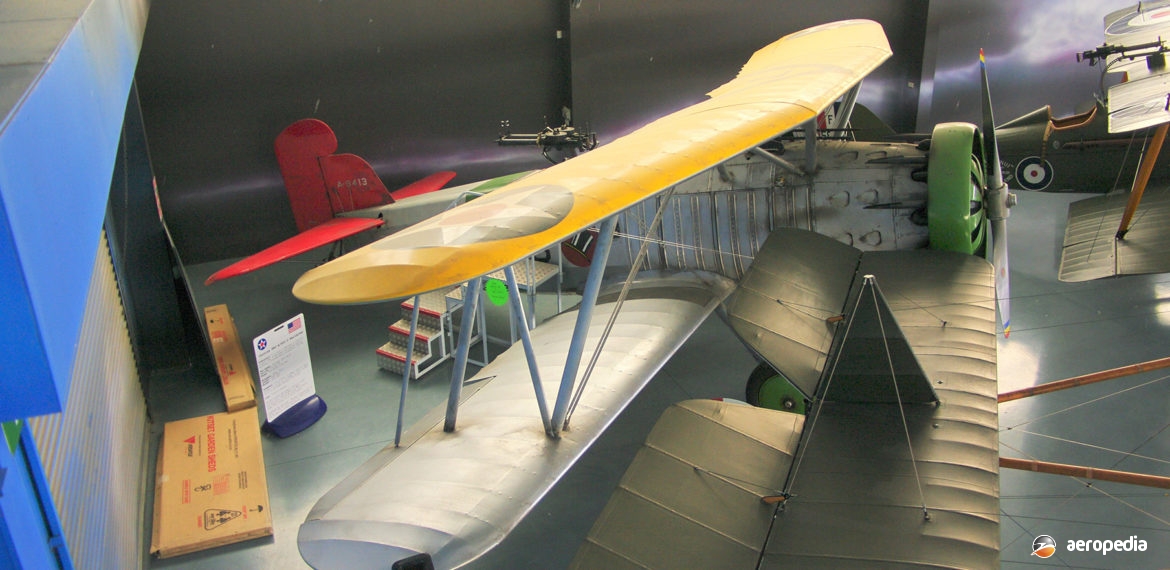Photograph:
Curtiss F8C Helldiver replica at Masterton, NZ in April 2012 (David C Eyre)
Country of origin:
United States of America
Description:
Two-seat fighter and dive bomber
Power Plant:
(F8C-1)
One 321 kw (420 hp) Pratt & Whitney R-1340B Wasp nine-cylinder air-cooled radial engine
Specifications:
- Wingspan: 9.75 m (32 ft)
- Length: 7.9 m (25 ft 11 in)
- Height: 3.2 m (10 ft 6 in)
- Wing area: 28.61 m² (308 sq ft)
- Max speed at sea level: 220 km/h (137 mph)
- Max speed at 3,048 m (10,000 ft): 208 km/h (129 mph)
- Landing speed: 93 km/h (58 mph)
- Fuel capacity: 454 litres (100 Imp gals)
- Service ceiling: 5,273 m (17,300 ft)
- Range: 608 km (378 miles)
- Empty weight: 1,107 kg (2,440 lb)
- Loaded weight: 1,777 kg (3,918 lb)
- Max loaded weight: 1,981 kg (4,367 lb)
Armament:
Two 7.62 mm (0.3 in) Browning machine-guns mounted in the lower wings; one 7.62 (0.3 in) Lewis machine-gun on a ring in the observer’s cockpit
History:
In the 1920s the Curtiss Wright Corporation developed a series of biplane fighters, variants of which were built as civil aircraft, including the Conqueror Mailplane, D-12 Mailplane, and the Lindbergh Special built specially for Charles Lindberg. A number were used for mail flights by National Air Transport, the survivors eventually being sold, a couple ending up smuggling spirits into the US during the Prohibition Era.
From these biplanes were developed the Army Experimental Curtiss XO-12 biplane, the Curtiss Falcon O-1 and Curtiss A-3 observation and attack aircraft that were supplied to the US Army. With some modifications the Curtiss Model 37D became known as the XF8C-1 for the US Navy, two being supplied, followed by four for the US Marine Corps as the F8C-1 in January 1928. These aircraft were intended to be multi-role aircraft, used in the fighter role, but could also be used as light bombers. During 1928 they were re-designated OC-1 and were used in the observation role. The new type was fitted with a Pratt & Whitney radial engine in lieu of the liquid-cooled units in previous aircraft.
Initial deliveries were six F8C-1s to the US Marines, followed by 21 F8C-3s later, being re-designated OC-1 and OC-2. In June 1929 an order was placed for a prototype XF8C-4, 27 F8C-4s and nine F8C-5s. The first F8C-4 was rolled out on 1 May 1930 with a Pratt & Whitney R-1340-88 engine, delivery of the F8C-5s commencing in September that year. An order in June 1930 was placed for 43, and these, after delivery, became known as the O2C-1. Two were built as the XF8C-6 with a supercharged engine; and one XF8C-7 was built, having a Wright R-1820-64 engine and being used as a commercial transport.
Further examples were ordered for the US Navy as the F8C-3 (later OC-2) and these, like the earlier models, had the 313 kw (420 hp) Pratt & Whitney R-1340 radial engine. Examples supplied to the US Marines became known as the VO-8M and VO-10M. Later the second XF8C-1 was fitted with a 448 kw (600 hp) Curtiss Chieftain engine and became known as the XOC-3. Further design changes were made, new models becoming the F8C-4 and F8C-5 for dive-bombing as well as two-seat fighters, becoming known unofficially in service as the Helldiver, this name being used on three different aircraft types produced by Curtiss over the years. Some 27 examples of the F8C-1 were built and about 75 of the other models.
In 2004, for the film ‘King Kong’, which was filmed in New Zealand, and which premiered in New York in December 2005, two non-flying replicas of the Curtiss F8C biplane were constructed from original drawings by Wingnut Films Ltd, a company involved with The Vintage Aviator Limited (TVAL) of Wellington. After use in filming it was expected one would be placed on display at The Aviation Heritage Centre at Omaka near Blenheim, NZ. In the event, one was placed in storage in Wellington and the other placed on display at Hood Aerodrome, Masterton.

